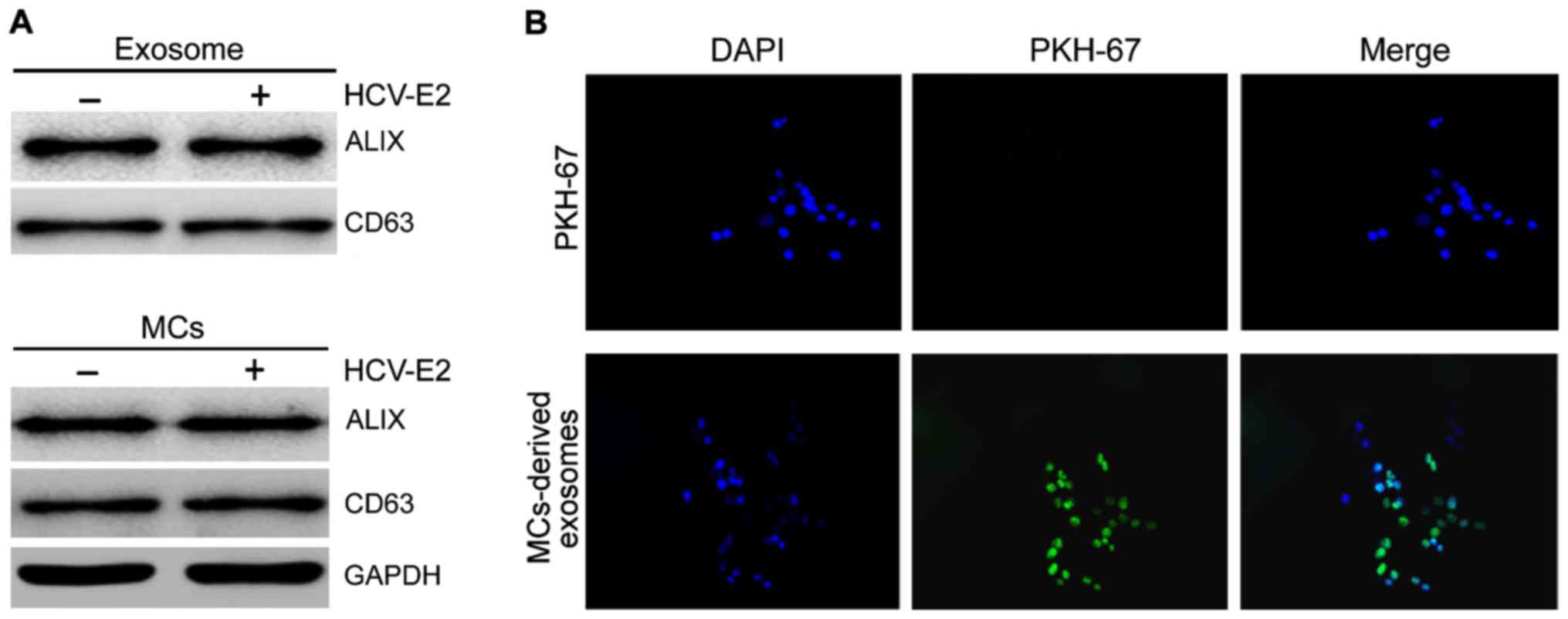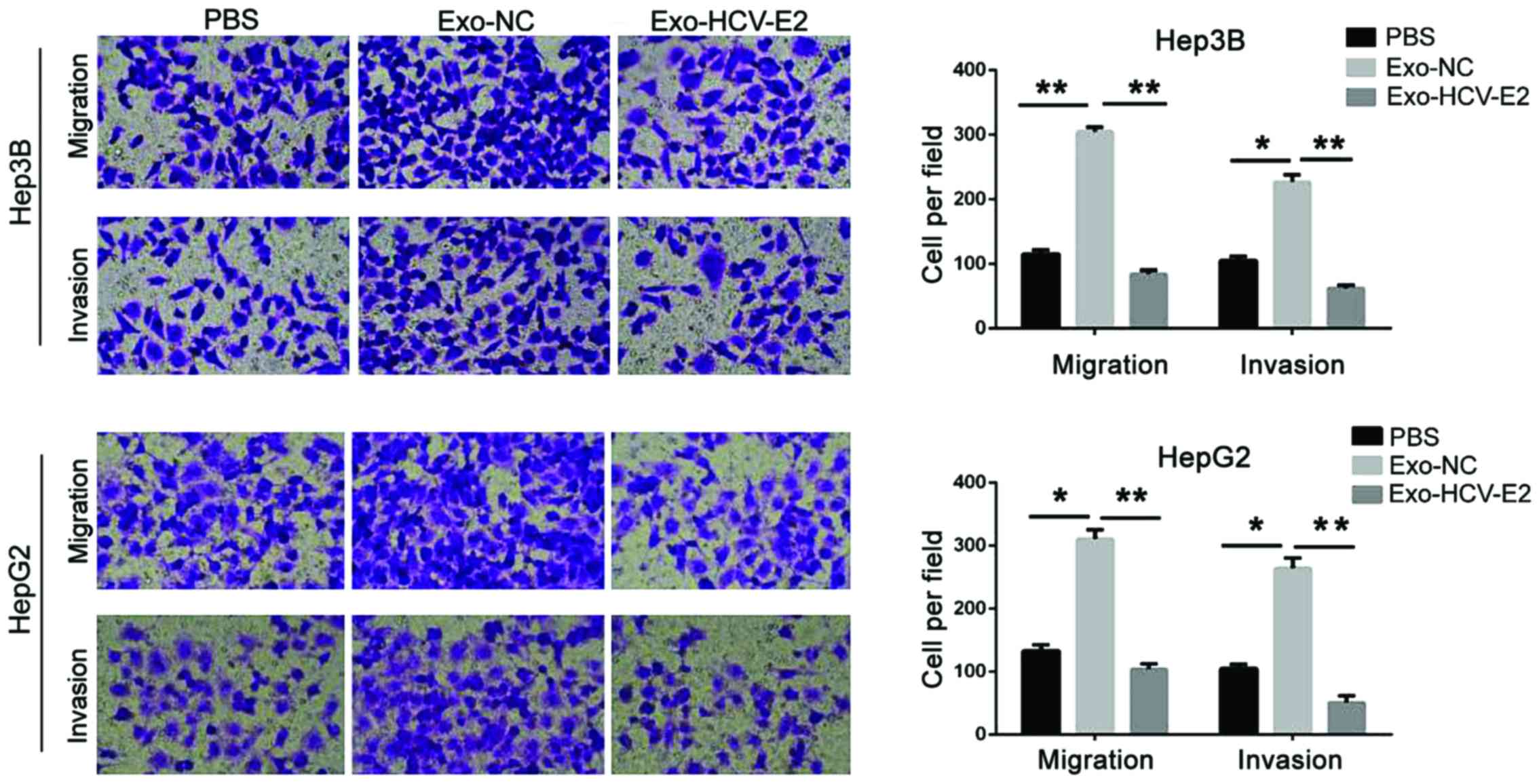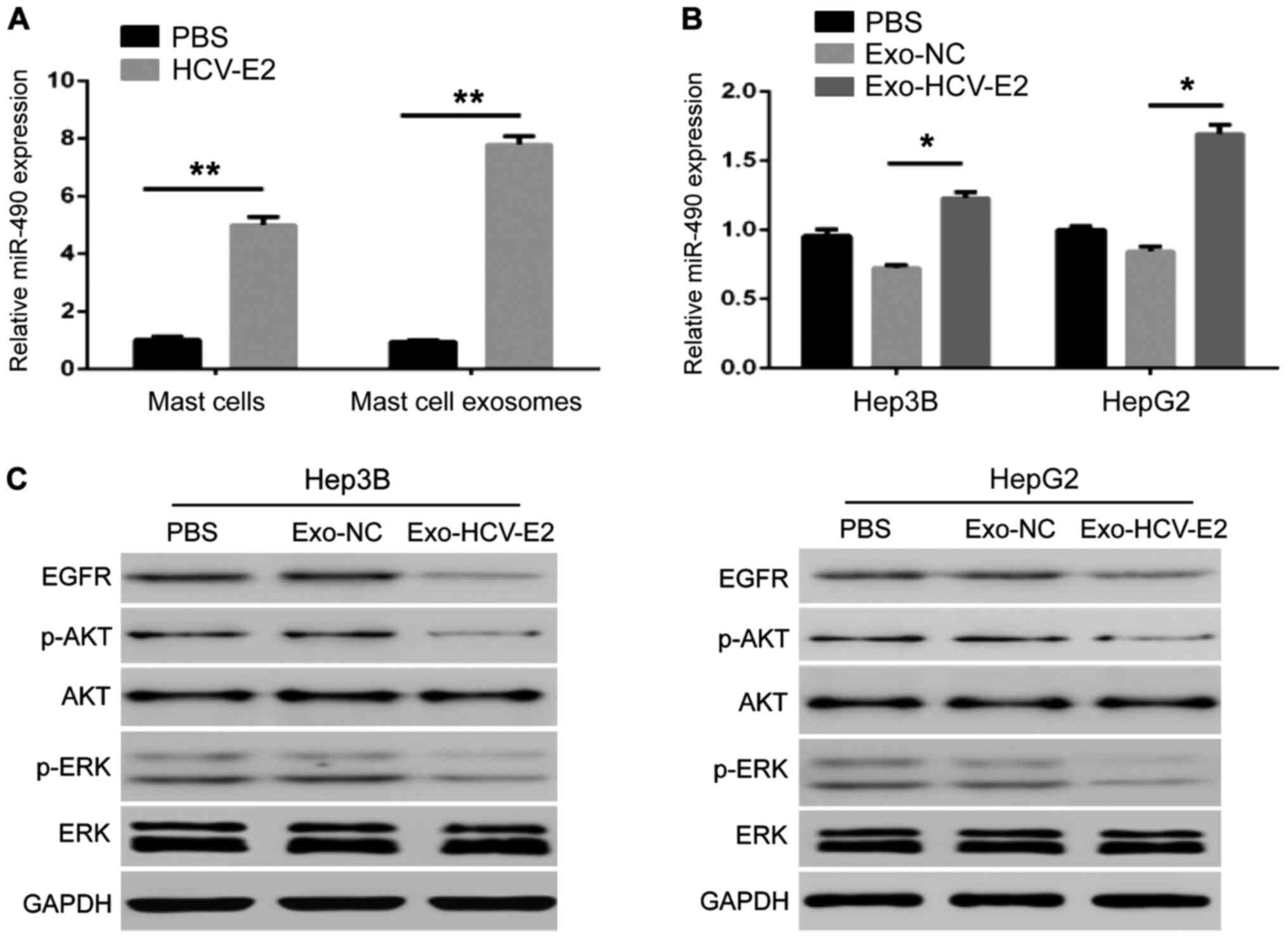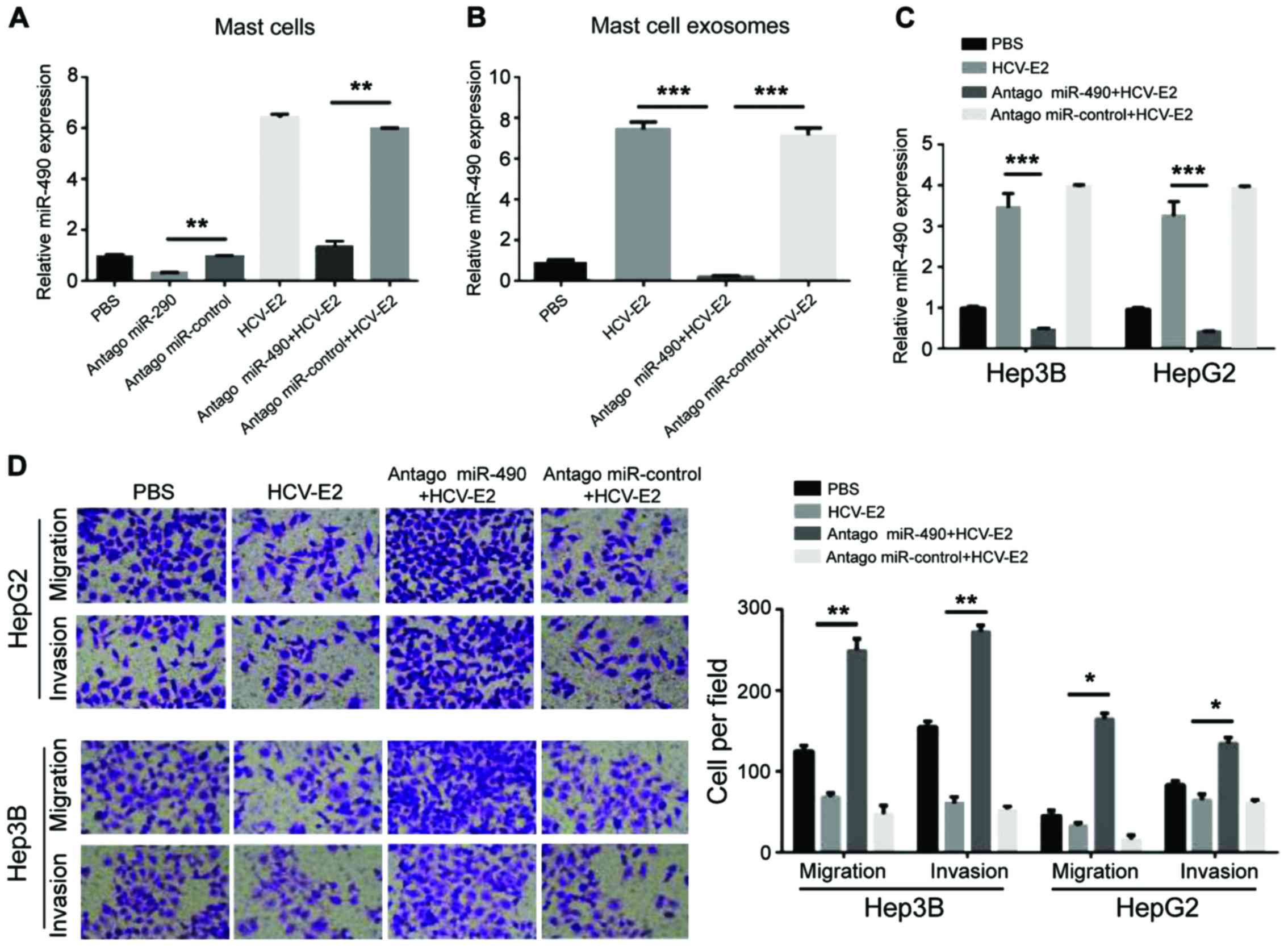HCV-E2 inhibits hepatocellular carcinoma metastasis by stimulating mast cells to secrete exosomal shuttle microRNAs
Retraction in: /10.3892/ol.2024.14434
- Authors:
- Published online on: June 20, 2017 https://doi.org/10.3892/ol.2017.6433
- Pages: 2141-2146
-
Copyright: © Xiong et al. This is an open access article distributed under the terms of Creative Commons Attribution License.
Abstract
Introduction
Hepatocellular carcinoma (HCC) is the main primary liver cancer and one of the most common malignancies worldwide. HCC incidence is high in China, and the new cases of liver cancer in China account for 45% of all the cases in the world. HCC mortality ranks third in the world and second in China among all cancers, with current increases in overall incidence and mortality rates (1). The treatment of liver cancer is regularly updated, but the overall efficacy of treatments has not significantly improved. Recurrence and metastasis are still the most important factors affecting the prognosis of patients with HCC (2). Therefore, studies on the mechanisms of HCC invasion and metastasis may be helpful for the identification of potential molecular targets for the new and effective treatments.
Tumor microenvironment is composed of various components such as matrix fibroblasts, endothelial cells, and extracellular matrix. Experts proposed that the abnormal tumor microenvironment is the main cause of tumor progression and metastasis. Studies have shown that mast cells (MCs) are enriched in the tumor microenvironment, and clinical and experimental studies have confirmed that MCs can promote the occurrence and development of tumors (3,4). Previous studies have shown that MCs can secrete histamine to inhibit the proliferation of HCC (5). Additionally, the increase of MCs usually indicate a poor prognosis of HCC patients (6). Thus, MCs in the tumor microenvironment can serve as a potential target for therapeutic intervention.
The interaction between tumor cells and MCs may be achieved by direct contact or through the release of secreted factors into the intercellular space. Exosomes are double membrane vesicles (diameter, 30–100 nm) released into the extracellular space to serve as important mediators of interactions between cells. Exosomes, which are derived from the fusion of the autophagic vacuole and the plasma membrane, are microbubbles produced by a variety of cells. After their release into the extracellular environment, exosomes can bind recipient cells to transfer their content. A variety of biomolecules, such as lipids, proteins, and nucleic acids (mRNA, microRNA, and DNA) are present in exosomes and can regulate the biological activity of recipient cells (7–10).
The hepatitis C virus E2 envelope glycoprotein (HCV-E2) plays an important role in viral infection and induction of host immune response (11) through binding the receptors on the surface of a variety of immune cells. HCV-E2 can also affect the biological properties of cancer cells. This suggests that HCV-E2 plays an important role in regulating the immune response and may be able to modulate the antitumor effect of tumor-infiltrating MCs. Here, we first tested the hypothesis that HCV-E2 can alter miRNA expression in MC-derived exosomes, thus affecting the invasion and metastasis of HCC.
Materials and methods
Cell culture and treatment
The human HCC cell lines HepG2 and Hep3B, and the MC line HMC-1 were obtained from the Cell Bank of the Chinese Academy of Sciences (Shanghai, China). Recombinant HCV-E2 antigen was from ImmunoDx (Woburn, MA, USA); cells were cultured in RPMI-1640 medium (HyClone; GE Healthcare Life Sciences, Logan, UT, USA) containing 10% fetal bovine serum (FBS) (HyClone) and penicillin/streptomycin (1:100, Sigma-Aldrich, St. Louis, MO, USA) at 37°C in a humid chamber containing 5% CO2.
Purification of exosomes
Exosomes were extracted from the cell culture medium using the total exosome separation reagent from Invitrogen (Carlsbad, CA, USA). HMC-1 cells were cultured in 10 cm culture dishes with FBS-free medium. After 24 h, the cell culture medium was collected and centrifuged at 10,000 × g for 30 min to remove cell debris. The total exosome separation reagent was added to the cell-free medium and incubated overnight at 4°C. The exosomes were collected by centrifugation at 10,000 × g for 1 h at 4°C and then resuspended in 500 µl PBS and quantified using BCA protein assay (Thermo Fisher Scientific, Inc., Waltham, MA, USA).
Labeling and tracking of exosomes
The exosomes in the supernatant of HCV-E2-stimulated MCs were labeled using the PKH67 Green Fluorescent Cell Linker kit (Sigma-Aldrich). The labeled exosomes were co-cultured with HepG2 cells for 24 h followed by elution. The uptake of labeled exosomes by receptor HepG2 cells was observed using a Leica TCS SP5 II laser scanning confocal microscope with a ×63 phase objective lens.
miRNA transfection
Human micrOFF hsa-miR-7-5p (MIMAT0000252) antagomir and micrOFF antagomir negative control no. 24 were purchased from RiboBio (Guangzhou, China). Human hsa-miR-490 antagomir or negative control were directly transfected into HMC-1 MCs at 200 nmol according to manufacturer's instructions.
RNA extraction and RT-PCR detection of miRNAs
The total RNA in the exosomes was isolated and enriched using the miRNeasy Mini kit (Qiagen, Gaithersburg, MD, USA) according to the manufacturer's instructions. Total RNA in HCC cells treated with exosomes (100 mg/ml) for 24 h was extracted using TRIzol reagent (Invitrogen). The mature miRNA-490 was reverse-transcribed with a specific RT primer and then quantified using a TaqMan probe according to the instructions (Applied Biosystems, Foster City, CA, USA). Human snRNA RNU6B (U6) was used to normalize the expression level of miRNA. The data were analyzed using the 2−ΔΔCq method.
miRNA microarray assay
Microarray assay of non-stimulated or HCV-E2-stimulated MC-derived exosomes was performed using miR marker reagents and hybridization kits, and human miR microarray kit (all from Agilent Technologies, Palo Alto, CA, USA). Total RNA (100 ng) from each sample was first phosphorylated and then labeled with Cyanine 3-pCp. The labeled RNA was purified using a Micro-Bio-spin column (Bio-Rad Laboratories, Inc., Hercules, CA, USA) followed by hybridization with human miRNA microarray slides at 55°C for 20 h. After hybridization, the slides were washed with gene expression wash buffer (Agilent) and scanned on an Agilent microarray scanner using Agilent's Scan Control A.7.0.1 software. The original hybridization intensity was obtained using Agilent's feature extraction software and 2,006 miRNAs were detected.
Western blot analysis
Total proteins were isolated from HCC cells treated with MCs-derived exosomes (100 µg/ml). Rabbit monoclonal phosphorylated ERK1/2 antibody (dilution, 1:500; cat. no. SC-4370) and rabbit monoclonal ERK1/2 antibody (dilution, 1:500; cat. no. SC-33746) were purchased from Santa Cruz Biotechnology, Inc. (Santa Cruz, CA, USA), and mouse monoclonal GAPDH antibody (dilution, 1:1,000; cat. no. M20006) was from Abmart (Arlington, MA, USA).
Migration and invasion assay
Cell migration assay: HCC cells were harvested and resuspended in serum-free RPMI-1640 medium and deposited on an 8 mm Transwell polycarbonate film (Corning Costar, MD, USA). Cell invasion assay: HCC cells were placed on an 8 mm aperture Transwell polycarbonate film (Corning Costar) coated with 50 µl Matrigel matrix (diluted 1:5 with serum-free medium). RPMI-1640 medium containing 10% FBS was added to the lower chamber. After 24 h of incubation, the cells on the surface of the membrane were removed and the cells that invaded into the membrane were fixed, stained, and counted with a microscope at ×200. The results were expressed as the mean of three independent experiments.
Statistical analysis
All statistical analyses were performed using Prism 6.0 software (GraphPad, San Diego, CA, USA). The data are expressed as mean ± SEM and analyzed by t-test or Mann-Whitney test. All cell culture experiments were performed at least in three independent replicates. P<0.05 was considered to be statistically significant.
Results
Internalization of HCV-E2-stimulated MC-derived exosomes in HCC cells
We collected exosomes from HMC-1 medium and confirmed the presence of two known exosomal markers, Alix and CD63, by western blot analysis (Fig. 1A). To determine whether exosomes could be internalized by HCC cells fluorescent PKH67-labeled exosomes were incubated with HepG2 cells and examined by confocal microscopy. To exclude contamination and non-specific migration of HepG2 cells, PKH labeled control was used. No increase in fluorescence was observed after incubation with PKH labeled controls, confirming the specificity of exosome internalization by HCC cells (Fig. 1B).
HCV-E2-stimulated MC-derived exosomes inhibit HCC cell migration
To analyze the effect of MC-derived exosomes on HCC cells, HepG2 and Hep3B cells were incubated with PBS, normal MC-derived exosomes, and HCV-E2-stimulated MC-derived exosomes. Compared with the PBS treatment, the migration and invasion significantly increased in HCC cells treated with normal MC-derived exosomes (P<0.05). However, HCV-E2-stimulated MC-derived exosomes significantly inhibited the migration and invasion of HCC cells (P<0.05) (Fig. 2). Thus, HCV-E2-stimulated MC-derived exosomes can inhibit HCC cell metastasis.
HCV-E2 stimulation leads to miR-490 enrichment in MCs, MC-derived exosomes, and recipient HCC cells
Exosome-mediated transfer of miRs is a novel mechanism for intercellular genetic exchange (12). To identify differentially expressed miRs in exosomes from MCs with and without HCV-E2 treatment, we performed a miR microarray. Compared with the exosomes from MCs without HCV-E2 treatment, we identified 19 differentially expressed miRs in the exosomes from MCs with HCV-E2 treatment. Of the 19, 15 miRs were upregulated and 4 were downregulated (Table I). miR-490 has been recognized as a tumor suppressor in human cancers. Based on this known role, we further studied the miR-490. QRT-PCR showed that HCV-E2 stimulation could upregulate miR-490 in MCs (Fig. 3A). The level of miR-490 in the HCV-E2-stimulated MC-derived exosomes was higher than that in normal MC-derived exosomes (Fig. 3A). In addition, HCV-E2-stimulated MC-derived exosomes incubated with the two types of HCC cells for 24 h increased the levels of miR-490 in HCC cells compared with the incubation with normal MCs-derived exosomes (Fig. 3B). These results indicate that HCV-E2 can not only upregulate miR-490 in MCs but also promotes the accumulation of miR-490 in MC-derived exosomes.
Table I.Differentially expressed miRNAs in exosomes derived from MCs with or without HCV-E2 stimulation identified by microarray analysis. |
To investigate whether the MC-derived exosome regulation of tumor metastasis is associated by the EGFR/AKT/ERK1/2 pathway, exosomes from MCs with and without HCV-E2 treatment were incubated with HCC cells. The expression of EGFR, phosphorylated AKT, and ERK1/2 in HCC cells showed that HCV-E2-stimulated MC-derived exosomes downregulated the expression of EGFR, and the phosphorylation of AKT and ERK1/2, but did not affect the levels of total AKT and ERK1/2 in HepG2 and Hep3B cells (Fig. 3C).
miR-490 in MC-derived exosomes regulated HCC cell migration
To investigate whether the migration of HCC cells can be regulated by miR-490 transported by exosomes, a miR-490 antagomir was transfected into MCs 24 h prior the HCV-E2 stimulation. Compared with the control group, qRT-PCR showed a decrease in miR-490 levels in MCs pre-transfected with antagomiR-490 (Fig. 4A). The levels of miR-490 in each group of exosomes showed that miR-490 was downregulated in exosomes from MCs pre-transfected with antagomiR-490 (Fig. 4B). QRT-PCR also showed that the levels of miR-490 in the two HCC cell lines were reduced after incubation with exosomes from MCs pre-transfected with antagomiR-490 (Fig. 4C). Consistent with the qRT-PCR results, the migration and invasion of HCC cells significantly increased after incubation with exosomes from the MCs pre-transfected with antagomiR-490 (Fig. 4D). Therefore, miR-490 from MC-derived exosomes can regulate the migration of HCC cells.
Discussion
Exosomes are considered important mediators of the interaction between tumor cells and their environment. Exosomes secreted by cancer cells can effectively disrupt tight junctions and vascular endothelial barrier integrity to promote tumor metastasis (13). Additionally, lung cancer cell-derived exosomes can regulate the migration of lung cancer cells through TGF-β and IL-10 signaling (14). Moreover, mesenchymal stem cell-derived exosomes can inhibit the proliferation of HCC cells (15). Furthermore, the function of immune cell-derived exosomes is mainly focused on immune regulation: MC-derived exosomes can activate B and T lymphocytes to play a role coordinating pro-inflammation and inflammation (16). Here, we found a new function of MC-derived exosomes in promoting migration and invasion of HCC cells. However, HCV-E2-stimulated MC-derived exosomes can inhibit the invasion and migration of HCC cells.
miRs are known to accumulate in exosomes and can be transferred between cells (12). Due to their gene regulatory function and relative stability, the transfer of exosomal miRs has drawn our attention as a mechanism regulating tumor growth and metastasis. miR-490 is a tumor suppressor miR that plays an important role in the migration, invasion, and growth of breast (17), colon (18) and ovarian (19) cancer. In addition, miR-490 can regulate the proliferation and metastasis of HCC cells by targeting ERGIC3 (20). About 70% of liver cancer cells express high levels of EGFR, whereas activated EGFR plays an important role in cell migration, which in turn lead to angiogenesis (21). Thus, inhibition of EGFR is a potential treatment of cancer (22,23). We found that HCV-E2 increased the expression of miR-490 in MC-derived exosomes and recipient HCC cells, thereby reducing the activity of EGFR/AKT/ERK1/2 pathway and inhibiting the migration of HCC cells. Moreover, transfection of antagomiR-490 in MCs reduced levels of miR-490 in MC-derived exosomes and recipient HCC cells and enhanced the migration and invasion of HCC cells.
We also report for the first time that HCV-E2 can contribute to the accumulation of miR-490 in MCs. However, the mechanism mediating the functional interactions has not yet been revealed. In fact, nuclear factor (NF)90 and NF45 complexes can negatively regulate miR-490 biosynthesis in HCC cells by inhibiting miR-490 precursors (24). Further studies are needed to investigate whether the upregulated miR-490 expression induced by HCV-E2 is mediated by the regulation of NF90 and NF45.
Collectively, we confirmed that MCs can transfer miR-490 to HCC cells through exosomes to inhibit the EGFR/AKT/ERK1/2 pathway, which in turn leads to the inhibition of tumor metastasis. In addition, we also discussed the potential of exosome miR-490 as a target for in vivo therapy.
References
|
Parkin DM, Bray F, Ferlay J and Pisani P: Global cancer statistics, 2002. CA Cancer J Clin. 55:74–108. 2005. View Article : Google Scholar : PubMed/NCBI | |
|
Liu Y, Zhang JB, Qin Y, Wang W, Wei L, Teng Y, Guo L, Zhang B, Lin Z, Liu J, et al: PROX1 promotes hepatocellular carcinoma metastasis by way of up-regulating hypoxia-inducible factor 1α expression and protein stability. Hepatology. 58:692–705. 2013. View Article : Google Scholar : PubMed/NCBI | |
|
Yamashita A, Saito T, Akaike K, Arakawa A, Yoshida A, Kikuchi K, Sugitani M and Yao T: Mast cell sarcoma of the sternum, clonally related to an antecedent germ cell tumor with a novel D579del KIT mutation. Virchows Arch. 470:583–588. 2017. View Article : Google Scholar : PubMed/NCBI | |
|
Miłek K, Kaczmarczyk-Sekuła K, Strzępek A, Dyduch G, Białas M, Szpor J, Gołąbek T, Szopiński T, Chłosta P and Okoń K: Mast cells influence neoangiogenesis in prostatic cancer independently of ERG status. Pol J Pathol. 67:244–249. 2016. View Article : Google Scholar : PubMed/NCBI | |
|
Lampiasi N, Azzolina A, Montalto G and Cervello M: Histamine and spontaneously released mast cell granules affect the cell growth of human hepatocellular carcinoma cells. Exp Mol Med. 39:284–294. 2007. View Article : Google Scholar : PubMed/NCBI | |
|
Tu JF, Pan HY, Ying XH, Lou J, Ji JS and Zou H: Mast cells comprise the major of interleukin 17-producing cells and predict a poor prognosis in hepatocellular carcinoma. Medicine (Baltimore). 95:e32202016. View Article : Google Scholar : PubMed/NCBI | |
|
Salido-Guadarrama I, Romero-Cordoba S, Peralta-Zaragoza O, Hidalgo-Miranda A and Rodríguez-Dorantes M: MicroRNAs transported by exosomes in body fluids as mediators of intercellular communication in cancer. Onco Targets Ther. 7:1327–1338. 2014.PubMed/NCBI | |
|
Wang J, Yao Y, Wu J and Li G: Identification and analysis of exosomes secreted from macrophages extracted by different methods. Int J Clin Exp Pathol. 8:6135–6142. 2015.PubMed/NCBI | |
|
Cocucci E, Racchetti G and Meldolesi J: Shedding microvesicles: Artefacts no more. Trends Cell Biol. 19:43–51. 2009. View Article : Google Scholar : PubMed/NCBI | |
|
Dreyer F and Baur A: Biogenesis and functions of exosomes and extracellular vesicles. Methods Mol Biol. 1448:201–216. 2016. View Article : Google Scholar : PubMed/NCBI | |
|
Sabahi A, Uprichard SL, Wimley WC, Dash S and Garry RF: Unexpected structural features of the hepatitis C virus envelope protein 2 ectodomain. J Virol. 88:10280–10288. 2014. View Article : Google Scholar : PubMed/NCBI | |
|
Valadi H, Ekström K, Bossios A, Sjöstrand M, Lee JJ and Lötvall JO: Exosome-mediated transfer of mRNAs and microRNAs is a novel mechanism of genetic exchange between cells. Nat Cell Biol. 9:654–659. 2007. View Article : Google Scholar : PubMed/NCBI | |
|
Zhou W, Fong MY, Min Y, Somlo G, Liu L, Palomares MR, Yu Y, Chow A, O'Connor ST, Chin AR, et al: Cancer-secreted miR-105 destroys vascular endothelial barriers to promote metastasis. Cancer Cell. 25:501–515. 2014. View Article : Google Scholar : PubMed/NCBI | |
|
Wang Y, Yi J, Chen X, Zhang Y, Xu M and Yang Z: The regulation of cancer cell migration by lung cancer cell-derived exosomes through TGF-β and IL-10. Oncol Lett. 11:1527–1530. 2016.PubMed/NCBI | |
|
Ko SF, Yip HK, Zhen YY, Lee CC, Lee CC, Huang CC, Ng SH and Lin JW: Adipose-derived mesenchymal stem cell exosomes suppress hepatocellular carcinoma growth in a rat model: Apparent diffusion coefficient, natural killer T-cell responses, and histopathological features. Stem Cells Int. 2015:8535062015. View Article : Google Scholar : PubMed/NCBI | |
|
Cheung KL, Jarrett R, Subramaniam S, Salimi M, Gutowska-Owsiak D, Chen YL, Hardman C, Xue L, Cerundolo V and Ogg G: Psoriatic T cells recognize neolipid antigens generated by mast cell phospholipase delivered by exosomes and presented by CD1a. J Exp Med. 213:2399–2412. 2016. View Article : Google Scholar : PubMed/NCBI | |
|
Jia Z, Liu Y, Gao Q, Han Y, Zhang G, Xu S, Cheng K and Zou W: miR-490-3p inhibits the growth and invasiveness in triple-negative breast cancer by repressing the expression of TNKS2. Gene. 593:41–47. 2016. View Article : Google Scholar : PubMed/NCBI | |
|
Xu X, Chen R, Li Z, Huang N, Wu X, Li S, Li Y and Wu S: MicroRNA-490-3p inhibits colorectal cancer metastasis by targeting TGFβR1. BMC Cancer. 15:10232015. View Article : Google Scholar : PubMed/NCBI | |
|
Chen S, Chen X, Xiu YL, Sun KX and Zhao Y: MicroRNA-490-3P targets CDK1 and inhibits ovarian epithelial carcinoma tumorigenesis and progression. Cancer Lett. 362:122–130. 2015. View Article : Google Scholar : PubMed/NCBI | |
|
Zhang LY, Liu M, Li X and Tang H: miR-490-3p modulates cell growth and epithelial to mesenchymal transition of hepatocellular carcinoma cells by targeting endoplasmic reticulum-Golgi intermediate compartment protein 3 (ERGIC3). J Biol Chem. 288:4035–4047. 2013. View Article : Google Scholar : PubMed/NCBI | |
|
Xu J, Zhang X, Wang H, Ge S, Gao T, Song L, Wang X, Li H, Qin Y and Zhang Z: HCRP1 downregulation promotes hepatocellular carcinoma cell migration and invasion through the induction of EGFR activation and epithelial-mesenchymal transition. Biomed Pharmacother. 88:421–429. 2017. View Article : Google Scholar : PubMed/NCBI | |
|
Guo T, Zhao L, Zhang Y, Liu G, Yao Y and Li H: A monoclonal antibody targeting the dimer interface of epidermal growth factor receptor (EGFR). Immunol Lett. 180:39–45. 2016. View Article : Google Scholar : PubMed/NCBI | |
|
Cao C, Lu S, Sowa A, Kivlin R, Amaral A, Chu W, Yang H, Di W and Wan Y: Priming with EGFR tyrosine kinase inhibitor and EGF sensitizes ovarian cancer cells to respond to chemotherapeutical drugs. Cancer Lett. 266:249–262. 2008. View Article : Google Scholar : PubMed/NCBI | |
|
Higuchi T, Todaka H, Sugiyama Y, Ono M, Tamaki N, Hatano E, Takezaki Y, Hanazaki K, Miwa T, Lai S, et al: Suppression of microRNA-7 (miR-7) biogenesis by nuclear factor 90-nuclear factor 45 complex (NF90-NF45) controls cell proliferation in hepatocellular carcinoma. J Biol Chem. 291:21074–21084. 2016. View Article : Google Scholar : PubMed/NCBI |













